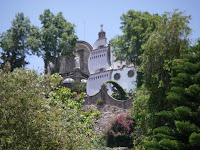The heat is oppressive in Olinalá. I struggled to lift off the weight of the heat that kept me in bed until mid morning, the ceiling fan on high. At first I thought my lack of energy stemmed from all of the excitement of the weekend – long bus ride to Olinalá, art show, post art exhibition birthday celebration of one of the judges, German. But…no. No, it was definitely the heat.
By early afternoon, settling for fresh juice as breakfast and lunch as it was too hot to eat; I made my way to Zacango. I was just in time to join Bruce and the kids in shucking the last of their dried corn. Some will be used to replant this year, and the rest will be used to feed the animals. Since the rains have come late this year, the community has just started to plow the fields for planting, which takes a week or so as it is done with burros. We finished the task in the cool of their house with the windows and doors barring the sun and heat from entering our refuge.
One of the tricks to beat the heat that Bruce and Jaime have learned is to find water, scarce though it might be. Since I had not been to Las Juntas, a neighboring community, we decided to investigate the water level of their creek for potential relief. From Zacango, Las Juntas is about 20-25 minutes on a curvy, dirt road, in the opposite direction of Olinalá. Many community members from Zacango have family in Las Juntas, and the two communities often join together for celebrations. Being a community that is nestled in the mountains, the houses were scattered along the mountain edge as descended into the community.
Diana and Enrique, friends of Hizee and Zam, joined us on our search for relief from the heat. We would have had a lot more children join us, but they were skeptical of the amount and the quality of water that we would find at the creek. After about three months with no rains, the first rains arrived in the area only two or three days ago. So along with the low level of water, it was less likely to be clear due to the recent rains.
While the kids were right, indeed the muddy water was lower than usual; it did nothing to take away from the sheer joy of splashing in the water. We walked along the creek bank until we found a shady area where the water pooled. The kids were soon in the waist-deep water, while I settled on the rocks, legs soaking in the cool respite from the heat. The periodic pig, dog or farmer leading some animals wondered by, but they were the only disturbance to the afternoon water frolic.



















































